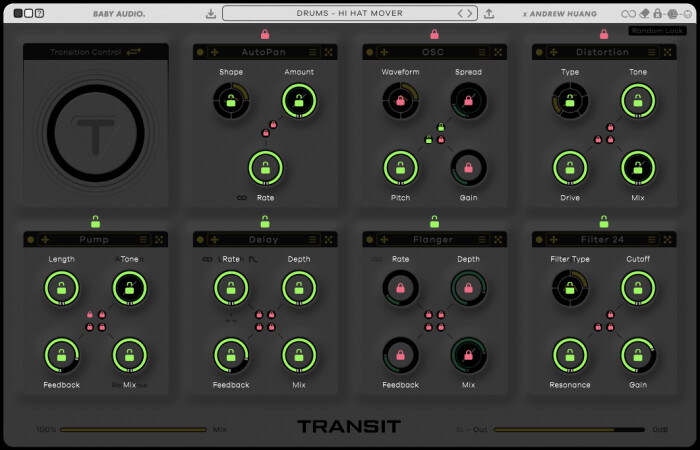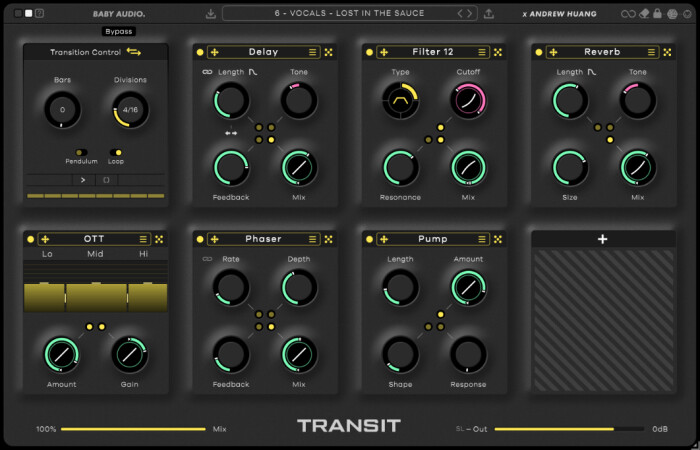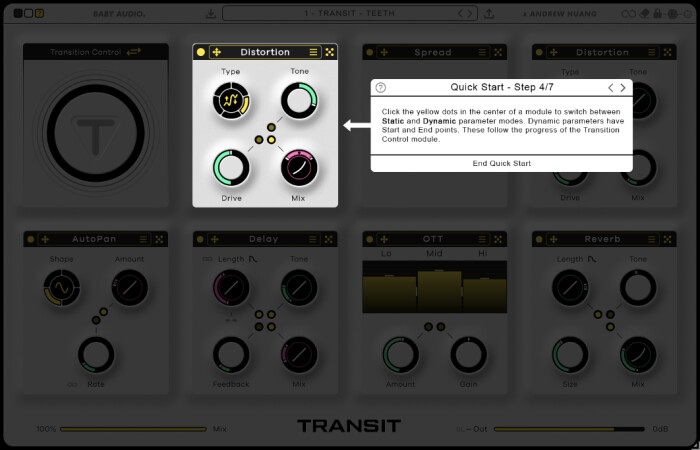Baby Audio, the up-and-coming Californian software developer, collaborated with Youtuber and artist Andrew Huang last year to design a multieffect plug-in dedicated to transitions. Was it a great idea?

For some time now, you must have noticed that the concept of the multieffect plug-in, which gives you the ability to control and adjust several effects in a single plug-in, has come back into vogue. It’s easy to see the appeal of operating in this way. It makes it possible to navigate complete effects chains via presets, to reproduce the feel of hardware equivalents in terms of visuals or gain staging (in the guitar world or in modular plug-ins featuring emulations of various processors such as those from Slate, IK Multimedia or Overloud), to put together effects for a specific purpose (such as the RC-20 Retro Color by XLN Audio and its multiple clones). For example, to enable signal separations into bands or transient components, (at Eventide and Wavesfactory), to create general modulations, or to automate with sequencers.
On these last two types, we’ve recently seen a few big hitters like Devious Machines Infiltrator², the ShaperBox 3.5 from Cableguys, Byome (Build Your Own Modular) and its multiband Triad version from Unfiltered Audio, Kilohearts Snap Heap, Sugar Bytes Effectrix 2/Turnado, or Arturia EFX Motions. Sometimes we question the value of multieffects offerings, particularly compared to dedicated single effects or plug-ins that can go further than their bundled equivalents in terms of functionality or even quality.
So when the Californians from Baby Audio — who we’re seeing all over the place at the moment (with the takeover of Denise Audio or the Atom and BA-1 synthesizers (which had a little success), released Transit in August of 2023, my first reaction was to puzzlement. I’d appreciated the qualities of their previous release BA-1, a real Synthwave machine far more interesting than a simple emulation of the simplistic Yamaha CS01, but I didn’t really understand the point of yet another multieffects plug-in. That is, until I heard Andrew Huang, the famous Canadian Youtuber and artist, known as much for his music, his song of unicorns and rainbows and his challenge videos, say that it was basically his plug-in idea, and not his first collaboration with developers (the famous Eurorack Ghost module from Endorphin.es as well as its pedal version).
This plug-in was conceived as a means of creating transitions with a fine-tuned workflow in your music tracks, via a large virtual knob, which controls easily assignable parameters in seven effect slots with 18 effect types available. You can use it live or automate it in your favorite DAW. So is it a mere gimmick or a useful new tool for the creative process?
Baby come back
Selling for €99/$99 excluding promos, and available on Windows, macOS and even iOS, Transit’s ergonomics are centered around the live use or automation of the large, Macro Knob, which is part of the Transition Control (TC) module, when the latter is set to Macro Mode. When you move the Macro Knob changes occur in the seven tabs next to it, each of which can potentially contain an effect, and all of whose parameters are reduced in number and always visible, which is an important feature. In fact, everything that impacts the sound is always visible and there are no hidden tabs with additional parameters for FXs.

Next, we were ready to work on the transition between the two sections. We wanted a reinforcement on the rhythmic part, like a characteristic snare drum repeat or tom fill to create a build-up. At the end of that, as the tension was at its peak, it abruptly dropped back (a drop), and we were at the next section.
During a build-up, you can gradually move the Transition Control value over two, four or eight measures, for example, towards 100% or less if you wish, then return instantly to zero or more gradually after the drop. This can be done manually, in a monotonous or undulating fashion, with the mouse or a controller, or managed directly by automation, recorded during a previous pass or written by hand in the automation section of your DAW. You can also speed up or slow down the control variation, using the controller, via the curves of the automation in the DAW parameter envelope, or in Transit, thanks to the line inside each parameter, which can be bent with the mouse in either direction to act on the speed of changes at the start of the run. In this very simple example, we obtained the following result with Transit only on the master :

It wasn’t bad, but it was a tad heavy-handed. We could have done better by setting the mix to 50 or applying the effect only to the drum bus, for example.

- Simple HP Transit House – Mix00:31
- Simple HP Transit House – Drums00:31
Your delay baby, your soul baby
Integrating the sliding high-pass filter effect into an arrangement was achieved very quickly. It was very DJ and “switching effects between tracks in Serato” in spirit. Transit is also filled to the brim with presets that use all the available effects, and these can be included in an arrangement in the same way, knowing that the plug-in also has a global mix control, a volume control, an end-of-chain limiter that can be switched on or off, and that these parameters, as well as those present in each FX, can be automated in the DAW.
In addition, the Transition Control module provides access to another means of creating transitions called the Motion Sequencer. It allows you to trigger a complete, linear transition from 0 to 100% by pressing a Play button, in sync with the transport bar at the start of a measure in your DAW. The Play button is automatable just like the Stop button. You can also set the length of the process by the number of bars, with finer divisions of 16. You can also trigger a return of the same length from 100% to 0% at the end of the transition. You can even put the movement of the TC on an infinite loop, like an LFO! There’s no need to automate anything in looping mode, as the sequence launch starts automatically when the song is played. It’s useful, for example, for processing a clip on a single track isolated in the DAW arrangement window or for trying out different presets in succession!

All in all, the plug-in is very user-friendly, with an integrated tutorial that launches when Transit starts up. Its manual (in English only) describes the software’s operations and contents fairly well, including its two skins, its resizable interface and a few additional options that allow you to define Transit’s behavior when the TC is at 0%, with all effects bypassed or not in this position, and the possibility of keeping the tails of the reverb and delay effects. Well thought out!
You don’t put just anything in your baby’s bottle
Another way to have fun, Transit offers a fairly sophisticated randomization function — which is an interesting constant in Baby Audio products. It allows you to randomly change the contents of effect slots, in terms of FX type and parameters. The effects included in the plug-in each have a limited number of parameters. That’s by design, because it reduces the number of parameter combinations that result in unusable tones and instead favors the quantity of sweet spots. You can access it by clicking once on a dice-shaped icon, or it can optionally be controlled by a MIDI event. But that’s not all: a dedicated randomization lock tab lets you indicate, in the current configuration, which parameters you want to be randomized. These can include the type of effect itself, which can remain fixed or variable, or even be disabled, and the degree of variation of a given parameter! There’s enough to keep you busy for a while when you’re finished browsing the factory presets, and it multiplies the chances of stumbling across something interesting by chance in a given composition session (perhaps not advisable live, though!).

Now let’s talk about the effects. There are 18 of them, most of which simply process the incoming signal. However, two very interesting ones in this context allow you to generate filtered white noise and a synthesizer oscillator sound, with the pitch assigned to one of the parameters. The sounds thus obtained are added to the input signal and can be processed by the effects present in succession in the signal path. Their order can be modified by simple drag and drop, opening up the possibility of creating risers and other sweeps on dedicated tracks! It’s worth noting that each effect type can only be present once, unfortunately, and also that they have their own presets.
The available effects, in addition to the waveform and noise generator, include Auto Pan, Bitcrusher, Chorus, Delay, Distortion, Filter with attenuation to –12 or –24 dB per octave, Flanger, OTT (a multiband compressor like that of Ableton Live with its famous preset), Phaser, Pitch Shift, Pump (compressor with a kick on each beat in sidechain and adjustable envelope), Reverb, Spread (effect on spatialization), Tremolo, and Utility (volume + pan + tone). There’s nothing really remarkable here, but let’s not forget that these effects are primarily present to generate transitions, and from that point of view there’s plenty to keep you busy. Also, Transit’s CPU load is consistently low, even with all the slots used (here on guitars and on electronic drum sounds).

- Transit Drums02:00
- Transit Guitars01:22
So of course we wouldn’t have said no to more filter variants, distortion and dynamics effects, granular processing, beat repeat, reverse etc. Perhaps in a future update? Note that the developer is said to be already working on the next version of Transit (currently 1.2), with, among other things, another preset browser that I imagine will be like the one that recently appeared in BA-1.
Dynamics in duty-free
Testing a plug-in, whose basic principle is to help us add ear candy in productions or live use, was bound to be a rather pleasant experience. Transit works very well for noise/special FX/sweeps/risers/transition effects, whether on instrument buses or on its own for generators. The low CPU load means that you’ll soon want to add it everywhere to enrich the space here and there, without it necessarily being too obvious. But that doesn’t mean you can’t go all out with it if that’s the effect you’re after (for example, here with DFAM, mister Aceboo’s Analog Rytm, spring reverb with feedback, and the return of random gardening videos on YouTube).

We’re not going to lie that most of the time what you do with it can be done with other plug-ins, such as some competitors I’ve already mentioned, others dedicated to risers and sweeps, or the plug-ins delivered with your DAW. It’s also oriented strongly toward electronic music. The critical aspects of this plug-in are the speed with which you achieve a given result, the desire to reuse it, and the simplicity with which you can realize your intentions in just a few clicks. Transit is equally at home in more classic effects without using the TC knob, such as a sidechain compression/pumping effect, an OTT on a bus, effects morphing that can find its place in a purely acoustic production, a delay on a portion of a voice, modulations on guitar sounds, a little distortion here and there, or a wave whose pitch can be automated continuously without sending MIDI information.




